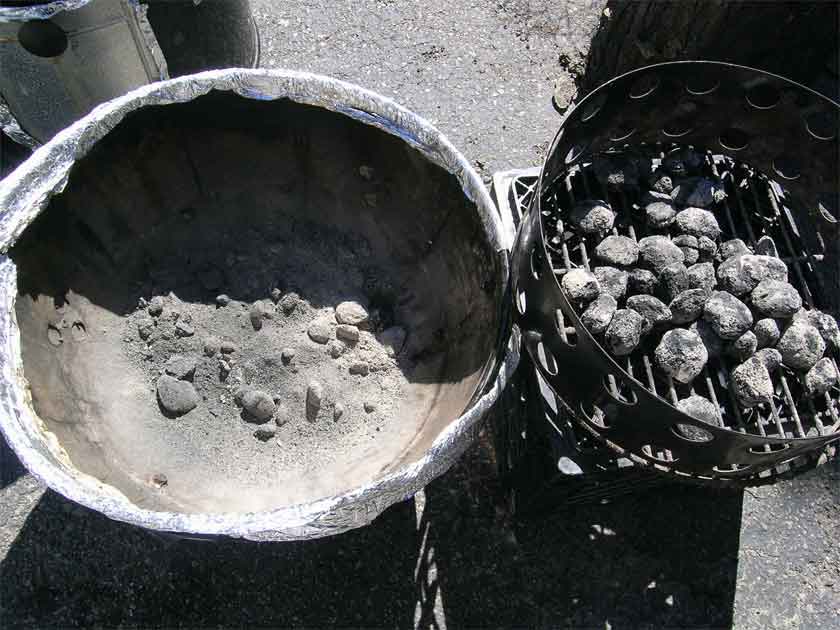<BLOCKQUOTE class="ip-ubbcode-quote"><div class="ip-ubbcode-quote-title">quote:</div><div class="ip-ubbcode-quote-content">Originally posted by Jeff Fried:
Anyone ever do a cooking time test of lump vs. briquettes? </div></BLOCKQUOTE>There is this article on the Naked Whiz that compares various brands of lump and Kingsford briquettes:
Comparison of burn times and ash production
What's confusing about the Naked Whiz article is that most of the results are based on burning charcoal by weight, while in reality we burn charcoal by volume (using a chimney starter as a measuring cup, or filling the charcoal chamber 1/2 full or heaping full). Later in the article, there's a confusing chart and some text that attempts to convert the burn time results from weight to volume. When viewed this way, Kingsford was in the middle of the pack--two lump samples were better, two were worse. The two better samples were Kamado extruded, which is a highly compressed product, even more dense than Kingsford, and Wicked Good charcoal, whose claim to fame is long burn times. Both have limited distribution in the US. The two worse samples were Big Green Egg lump and Cowboy.
Another question I have about the article is that they tried to maintain a temperature of 450*F during the test. For my purposes, a range of 225-250*F would be more meaningful, because it's when I'm cooking overnight in this temp range that I really care about burn time.
In addition, there is a sidebar in Cook's Illustrated magazine from July/August 2005, p.14, titled "What's the Hottest Charcoal". They filled 6-quart chimneys with lump or briquettes. They fitted the cooking grate of an unspecified grill (probably a Weber kettle, since that's what they use on their TV show) with 7 thermocouples and recorded heat levels in 5 minute intervals. They ran the test a dozen times and analyzed the data. From the article:
<BLOCKQUOTE class="ip-ubbcode-quote"><div class="ip-ubbcode-quote-title">quote:</div><div class="ip-ubbcode-quote-content">The results were startling. In every test, the briquettes burned as hot, or hotter, than the hardwood (charcoal). In grilling tests, the fires produced nearly identical heat for about 30 minutes--enough time for most quick grilling tasks. From there on, the hardwood coals quickly turn into piles of ash, while the briquettes slowly lost heat. </div></BLOCKQUOTE>
There is a chart in the sidebar that shows how the temperatures went with the lid on the grill (I assume top and bottom vents were left wide open). It shows briquettes hitting 500*F after 20 minutes, then dropping along a fairly straight path to 50*F at 4 hours 10 minutes. For lump, 450*F after 20 minutes, then dropping down a much steeper path to 50*F at 1 hour 50 minutes.
At least the Cook's sidebar uses the right measure in their test--volume--but they do an uncontrolled burn, which is not what we do in the WSM. We fill the charcoal chamber with fuel and use the Minion Method and vent settings for a controlled burn. In this regard, the Naked Whiz test is better--at least they adjusted the vents in the small Big Green Egg (oxymoron?) to maintain 450*F as long as they could, then stopped the timer when it reached 300*F. Also, we don't know what brands of briquette or lump they used. I would assume they used Kingsford, but running Kingsford against Wicked Good would be a different race than running Kingsford against Cowboy, as the Naked Whiz showed.
It's all interesting stuff, but it points out that there are many variables to take into account. For example, Bryan noted that he can get more lump in the charcoal chamber by packing it in tightly. Sometimes when I fill a chimney starter with briquettes, I shake them down inside, sometimes I don't. It's variables like these, along with various fuels, that make it hard to compare one person's results with another's.
I like the wisdom of Jim Minion's comment on this subject in another thread:
<BLOCKQUOTE class="ip-ubbcode-quote"><div class="ip-ubbcode-quote-title">quote:</div><div class="ip-ubbcode-quote-content">No matter what you cook on or use for fuel there are trade offs. If you use Kingsford, you have steady temps and predictable burn times. Trade off is more ash than some other charcoals, so you deal with it.
If you use lump there can be shorter burns, some heat spikes and higher fuel costs but you have less ash. Still have to deal with those conditions.
BBQ is learning to deal with the situation that's presented to you.
I have been using Kingsford for a lot of years and can not complain about the results. I also use lump regularly and as anything else it's not equal in quality and results based on the material that the lump is made from.
Learn to deal with the condition you are presented with because under different weather conditions you will get different results.
Low and slow is about how you handle the conditions as they present themself. </div></BLOCKQUOTE>Regards,
Chris

